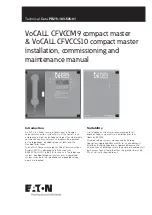
4
Technical Data
PR211-183-505-01
VoCALL CFVCCM9 compact master
EATON
www.eaton.com
Mains connection
>3mm
3A
>0.75mm
2
<2.5mm
2
UNITY
DAU
VoCALL
Compact
M9 or S10
Main
Distribution
Board
Each compact requires a 3A spur, returning to a breaker clearly
marked “
EVCS DO NOT TURN OFF
”. If the units are distributed
around a site it is essential all units are on the same mains phase,
as they are classified TEN 230V, powering from different phases
can mean a 440V potential can be present in a unit during a
major fault incident.
Batteries
The compact requires one number 12V 5AH sealed lead acid
batteries to provide backup power in the event of mains failure as
defined in BS5839pt9 for 24 hours standby and 3 hours operation
when powered by normal mains supply.
For 72hour standby and 1 hour operation one number 12V 17AH
battery is required, these will need to be fitted in an external
battery enclosure. The monitored charger in the VoCALL Compact
unit is capable of charging and monitoring these batteries.
Safety information:
Sealed Lead acid batteries contain sulphuric acid which can
cause burns if exposed to the skin. The low internal resistance
of these batteries means large currents will flow if they are
accidentally short circuited, causing burns and a risk of fire-
exercise caution when handling batteries.
Power up procedure:
Always apply mains power before connecting batteries. Do not
commission the VoCALL Compact unit on batteries, as the high
inrush current required by the power supply may rupture the
battery fuse. Always connect the Positive (Red +) terminal first,
then the Negative (Black -)
To down power reverse the power up sequence.
Outstation wiring
The VoCALL compact unit requires programming to determine the
outstation configuration;
Four types of handset are allowed on the system, type A (fixed
phone) type B (hands-free refuge points), disabled toilet alarms
and jack plates.
For jack points a 10K EOL resistor is required at the OUT of the
last plate on the line.
Cable Guidance for VoCALL compact
unit and outstations
Following the publication of BS5839pt9:2011, the guidance on
cables for the VoCALL Compact unit has changed, following a
relaxation in the requirements of the standard.
Type A outstations
Any system with fire fighting telephones (Type A outstations)
must have all wiring to these outstations and any necessary
network cables interconnecting parts of the system in Enhanced
fire rated cables.
Type B outstations
In buildings under 30 metres in height, or any building with
sprinklers fitted, the wiring of Type B (hands-free) disabled refuge
points may be in standard fire rated cable as long as the planned
evacuation will be completed within 30 minutes. If the building is
over 30metres in height without sprinklers, or where the
evacuation will take place over multiple stages exceeding 30
minutes, enhanced fire rated cables must be used.
Disabled toilet call points
The revised BS5839pt9:2011 now recognises the addition of
disabled toilet call systems to the VoCALL Compact unit, however
gives no guidance on their use, as this is in Building Regulations
Approved Document M.
There is no requirement for these systems to be monitored or
battery backed. However with the VoCALL VCEA toilet extension
we have included these features as standard. The only cable
requirement may come from the building design statement,
and typically this will require low smoke and fume cables (LSF),
although they can also be wired in standard fire rated cable for
ease of identification.
Combined systems
When a system consists of a mix of Type A and Type B
outstations, the wiring must be enhanced fire rated for any
shared resource such as network cables, but individual spurs to
type B outstations can be wired in standard fire rated cable as
long as the distance covered by that cable does not exceed 30
metres vertically in non-sprinklered buildings, or the evacuation
plan for this segment of the building will not exceed 30 minutes.
General guidance
In complex buildings or where systems are being quoted without
access to the fire evacuation plan we recommend all wiring to
be enhanced, or suitable caveats and detailed assumptions are
placed on the design certificate required by BS5839pt9:2011.































